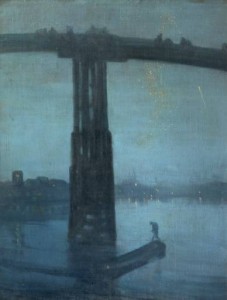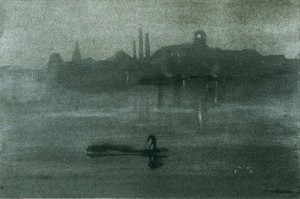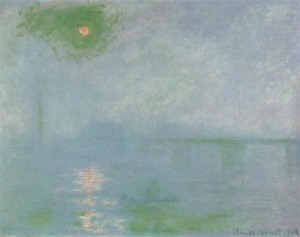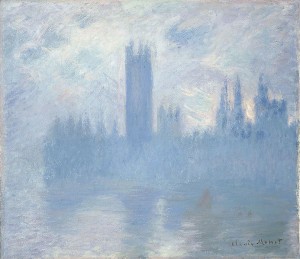London exploded in size in the nineteenth century. In 1801 it had just over 1 million inhabitants. By 1901 the population had reached 6.5 million with the rate of growth accelerating as the century ran its course (a full 1 million was added to the population in the 1890’s alone, which is almost a 20% increase in just 10 years).
These new people required homes and coal fires to heat them. Many worked in London’s thriving heavy industry which was powered by vast coal burning engines. The smoke that spewed out of London homes and factories in the second half of the century was so great that it began reacting with the damp winter weather to produce thick shrouds of black fog that could envelop London for days and weeks. The worst occassion was from November 1879 to March 1880 when the fog was almost continuous and London was submerged in a strange dream world for five months. The fogs were dangerous for Londoners; hundreds died of asthma and other breathing difficulties caused by the condition. It certainly puts our recent week of snow and the chaos it caused into perspective. The gas street lights were left on all day and night and they lent the fog a yellow tinge. Locals called the condition a “London Particular” (Dickens uses the phrase in 1852/3’s Bleak House). A correspondent from the New York Times in 1871 described “a fog of the consistency of pea soup”. London responded by playfully renaming pea soup as “London Particular” – a rare example of soup imitating life. You can get the sainted Delia Smith’s recipe here. In 1905 the word “smog” was invented to describe the condition. And London became known as “The Big Smoke”
The swirling smogs changed distinctly how London looked and was experienced, of course. They hid secrets and made strange the familiar. This created an exciting new environment for art in general and the mysterious in particular. Sherlock Holmes (who was written about by Conan Doyle between 1887 and 1927) exists in a London that is charcterised by confusion and fog. Holmes role is to cut through both to deduce what is really happening in the city. You can even see some smog in the CGI landscapes of the new Guy Ritchie Sherlock Holmes film. Robert Louis Stevenson’s Dr Jekyll and Mr Hyde occupy and explore the same landscape and here the fogs hide a multitude of sins. The popular image of Jack The Ripper is of a terrifying sadistic murderer stepping out of the mists to commit his atrocities before returning to the mists’ cloak of invisibility as a means of escaping into anonymity. It would seem that in the Ripper’s case the fog was not to blame, however, as none of the Ripper murders was committed on a foggy night. This has not stopped the film makers who use the fog as though it were the Ripper’s accomplice.
Artists of all varieties were inspired by the shape shifting qualities of the fog. The two most famous were James McNeill Whistler and Claude Monet who were both featured in a great Tate Britain exhibition on the subject back in 2005. You can still see the website here which locates many of the pictures geographically.
Whistler (who was an American artist based in London) painted a series of Nocturnes in the 1870’s showing London affected by fog.
Claude Monet came over to London especially for the fog in 1899-1901, “I adore London…But what I love more than anything is the fog.” His remarkable pictures of London and particularly its waterfront and bridges capture some of what London must have been like at the peak of the smogs.
The fogs reduced in scale in the twentieth century before reappearing with vengeance in the 1950’s. This prompted the Clean Air Act of 1956 which saw them banished.



